Cardiff Corporation Tramways
History
In 1898, Cardiff Corporation acquired powers to build and run its own tramway, as well as to compulsorily purchase the two local horse tramways, which were owned by the Cardiff Tramways Company and the Cardiff District and Penarth Harbour Tramways Company.
Although the corporation did not take possession of the CTCo's tracks (and its tramway assets) until the 1st January 1902, preparations were already well in hand by 1900, including the construction of new lines and reconstruction of existing CTCo lines (for overhead electric working). Following its take-over of the CTCo, the corporation continued to work the horse-drawn system whilst conversion to electric traction proceeded, the first electric service commencing on the 1st May 1902, and the last horse tram service running on the 17th October the same year.
Acquisition of the CD&PHTCo's line was, however, proving to be a more protracted affair, the corporation being unwilling to go to arbitration and the company holding out for a better price. Meanwhile, the CTCo continued to work the line (as the lessee) even though its own system had now passed into the hands of the corporation. An acceptable price was eventually agreed, the corporation finally taking possession on the 10th February 1903, and immediately closing the tramway for conversion.
The new electric tramway was an immediate success, large numbers of passengers being carried, such that the concern turned a profit, despite having to service significant interest and loan repayments. Although the system was largely complete by the mid-Edwardian era, a few extensions, mostly of a minor nature, were built over the next 25 years. At its maximum, the corporation operated 19.51 miles of standard-gauge tramway, comprising lines: eastwards to Roath; southeastwards to Roath Dock; southwards to the Pier Head, Clarence Rd and Clive St (Grange); westwards to Victoria Park (Canton); northwestwards along Cathedral Rd to Llandaff Fields; northwards to Gabalfa (via Cathays) and Roath Park (via Penylan Rd). Despite some early talk of a building a connection to Newport Corporation Tramways (some 10 miles distant), the system remained isolated all its life.
The tramway was well-run and well-maintained, which allowed it to survive the rigours of the Great War, with its staff shortages, reduced maintenance and severe restrictions on track and tramcar renewal, much better than many other systems, emerging from the conflict in run-down, but hardly disastrous condition.
Although the corporation introduced its first bus services on the 24th December 1920, it clearly viewed the tramway as the core of its transport system, so it invested heavily in the system in the 1920s, relaying almost all of the track, building extensions and totally modernising the tramcar fleet, such that by 1927, 112 of the 147 licensed tramcars were either new or substantially rebuilt. Unfortunately, the manager who had presided over this significant investment — R L Horsfield — left in 1928 to join Leeds Corporation Tramways. His replacement, William Forbes, was an adherent of buses, and it was not long before a further planned extension was stopped, and the first tramway route was closed (Salisbury Rd on the 4th January 1930), ostensibly due to the inefficiency of having to use and maintain a fleet of low-capacity, single-deck trams to work the line, which had a low railway bridge.
Whilst there was no headlong rush to abandon the tramway, it was fairly clear that when major renewals were due (such as track), a policy of bus substitution would be pursued; however, the investment of the 1920s meant that this was some way off, so Cardiff's trams continued to dominate the local transport scene for some years to come. The department's name was nevertheless twice changed to reflect the changing modes of transport, in 1921/1922 to Cardiff Corporation Tramways and Motors, and in January 1933 to Cardiff Corporation Transport.
The next closure came in 1936, at the recommendation of Forbes, little account being taken of the fact that the tramcars on the affected route were barely ten years old, and in good condition, whilst corporation buses which had been delivered in 1929 were already being replaced (at not inconsiderable expense).
On the 8th May 1939, the council formally decided to abandon the tramway, though Forbes wasn't to have everything his own way, as they decided — against his advice — that trolley buses should form a significant component of the transport system moving forward.
Even though the truncated tramway was carrying large numbers of passengers, the new policy meant that during the Second World War, maintenance was kept to the absolute minimum, as it was all going to be replaced anyway. As a result, the tramway (track and tramcars) become ever more decrepit, reinforcing the public's anticipation of its replacement, a target that was finally achieved on 19th February 1950.
Uniforms
Following its takeover of the Cardiff Tramways Company on the first day of 1902, the corporation continued to run horse-car services until their withdrawal nine-and-a-half months later. A single surviving photograph (see below) strongly suggests that horse-tram drivers continued to wear informal attire, as they had in CTCo days, but that conductors were issued with uniforms (greatcoats and peaked caps). These were in all likelihood identical to the uniforms provided to electric tramcar crews.
Staff working the new electric services (introduced on 1st May 1902) were certainly issued with new uniforms, which were of blue serge with white piping (later changed to red) and comprised: double-breasted, lancer-style tunics with five pairs of brass buttons (narrowing from top to bottom) and stand-up collars; the latter carried an employee number (in individual metal numerals) on the bearer's left-hand side, and system initials — 'C C T' — (in individual metal letters) on the right. Caps were soft-topped with a glossy peak and carried script-lettering grade badges — either 'Motorman' or 'Conductor' — above which a small municipal shield badge was mounted, almost certainly the same device used on the early-period uniform buttons (see link). The insignia were almost certainly brass to match the buttons. The soft-topped caps were relatively quickly superseded by peaked caps with tensioned crowns (tops), a change which had definitely taken place by 1904.
In 1906, Cardiff was granted new municipal arms by the College of Heralds; these incorporated a red dragon and new motto, and were quickly supplemented (in 1907) by a grant of goat and hippocamp (mythical seahorse) supporters. At some point after this, the corporation presumably began the process of replacing the old municipal arms, which for the tramways, led to new buttons (see link) and the issuing of a new design of cap badge, which consisted of the new arms, within a wreath, all above the full system title: 'CARDIFF CORPORATION TRAMWAYS'. The tunics were unaltered (stylistically), but now incorporated leather shoulder reinforcements, as well as epaulettes; the latter were fastened with buttons and bore a small municipal-device badge. The elaborate cap badge lasted right through to the end of the Great War, shortly after which, it was displaced by the badge that was used on the epaulettes.
Later in the system's life, probably in the 1930s, modern, double-breasted jackets with lapels were introduced; the collars more than likely bore one-piece, chrome 'CCT' system-initial badges, though photographic evidence is as yet inconclusive. Following the change of name in 1933, new uniforms would have borne Cardiff Corporation Transport insignia and buttons. Perhaps the most noticeable change was the introduction of a striking red enamel cap badge bearing the title 'CARDIFF CORPORATION TRANSPORT'. The new buttons and insignia were brass initially, later changing to chrome.
Tramcar crews were also issued with double-breasted greatcoats with five pairs of buttons and high, fold-over collars; the latter did not bear any badges. At some point, probably in the late-Edwardian era, epaulettes were added to these garments; these had a button fastening, and carried the new municipal-device badge, together with a brass employee number (at the outer end).
In the mid-Edwardian era, licence badges were evidently used for a short period; these were round, possibly enamel, and appear to have borne script initials sloping diagonally from the top left to the bottom right. They were briefly reused in the Great War to confer authority on conductresses, prior to them being issued with uniforms (see below).
In the early years of operation, inspectors wore typical tramway inspector garb, i.e., single-breasted jackets with hidden buttons (or more likely a hook and eye affair), two slit hip pockets and stand-up collars; the latter bore 'Inspector' in embroidered script lettering on the bearer's left-hand side, and system initials ('C C T') on the right, again in embroidered script lettering. The jackets (including the slit pockets) were edged in a finer material than the main jacket, with the sleeves embellished with a chevron of the same material. Headgear took the form of a peaked cap with a steeply inclined glossy peak (often referred to as a drooping-peak cap); the cap bore a large embroidered cloth badge comprising a municipal device within a wreath. At some point, probably the same time as tramcar crews' uniforms were changed, the style of uniform was subtly altered, still single-breasted, but now with slit breast pockets rather than hip pockets. Around the same time, the drooping-peak cap was superseded by a cap with a tensioned crown (top) and braided peak; this carried an elaborate municipal-device badge that appears to have been an embellished version of the standard badge worn on employee's epaulettes. This elaborate cap badge was also worn on inspectors' epaulettes. Following the change of name in 1933, new round cap badges were issued; these were identical in form to those issued to tramcar crews, but with deep-blue enamel rather than red.
Inspectors were also issued with long overcoats; by the 1920s, these had lapels rather than the high fold-over collars worn by motormen and conductors, and were seemingly also devoid of epaulettes. The lapels bore embroidered insignia, probably 'C.C.T' on the bearer's right-hand side and 'Inspector' on the left. In later years, long gabardine overcoats were probably worn.
In common with many tramway operators, Cardiff recruited female staff during the Great War to replace male employees lost to the armed forces. The first ladies are thought to have been employed in 1917, two being trained as motorwomen, the rest serving as conductresses; by the end of the war, over 200 women were employed. These ladies initially wore informal attire, the sole badge of office being a round licence, which appears to have been the same pattern that tramcar crews wore in the mid-Edwardian era. Photographs of these ladies in their uniforms are rare, so some of what follows has had to be inferred. An excellent studio portrait has, however, survived, which shows a lady in a double-breasted, lancer-style tunic, which appears to have been virtually identical to those worn by the men (including insignia), these would presumably have been tailored to fit the female form. Unusually, the caps were very similar, if not identical, to those worn by the men; they carried the same municipal tramways cap badge, though in all likelihood, this was often replaced by a regimental sweetheart badge, a practice that was very common right across UK tramway systems during the Great War. Female employees were also issued with single-breasted tailored coats (possibly with the line of buttons off centre), epaulettes, lapels, and a waist belt with centre button; as was the case with male employees, the collars were devoid of insignia.
Conductresses were again employed during the Second World War, the first of these ladies starting work on the 16th April 1941. In 1944 their numbers had risen to 257; details of their uniforms are, however, currently unknown.
Further reading
For a history of Cardiff's tramways, see 'Cardiff's Electric Tramways' by David Gould; Oakwood Press (1974).
Images
Horse tram drivers and conductors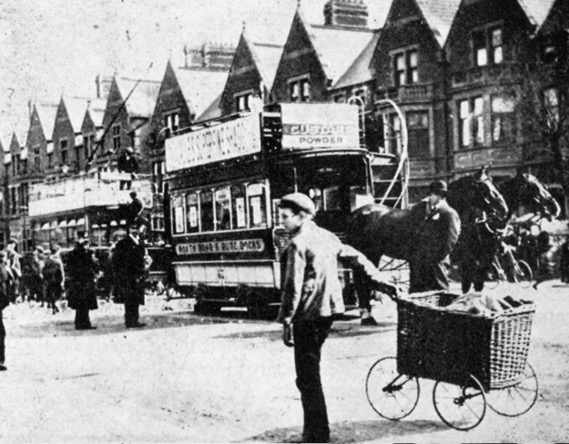
A very poor quality photograph of an unidentified horsecar (possibly No 67) somewhere on the Roath-Bute Docks route — photo undated, but definitely taken in 1902 after the corporation take-over, as the tramcar on the left is an electric vehicle. The two men standing in front of the trams, to the left, are probably the respective conductors; both men are wearing greatcoats and peaked caps. The horse-tram driver, standing in front of the horses, is wearing informal attire, including a bowler hat.
Motormen and conductors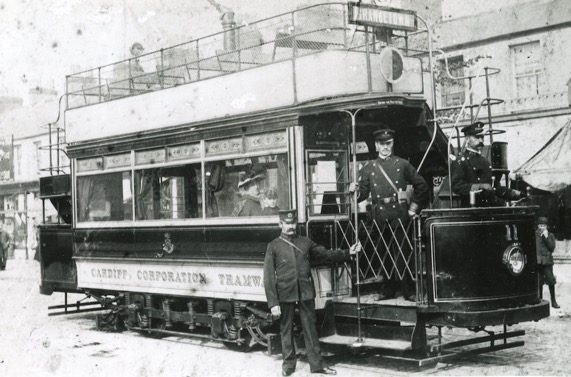
An inspector and crew with Tramcar No 11, bound for Grangetown — photo undated, but probably taken in 1904. With thanks to the National Tramway Museum. 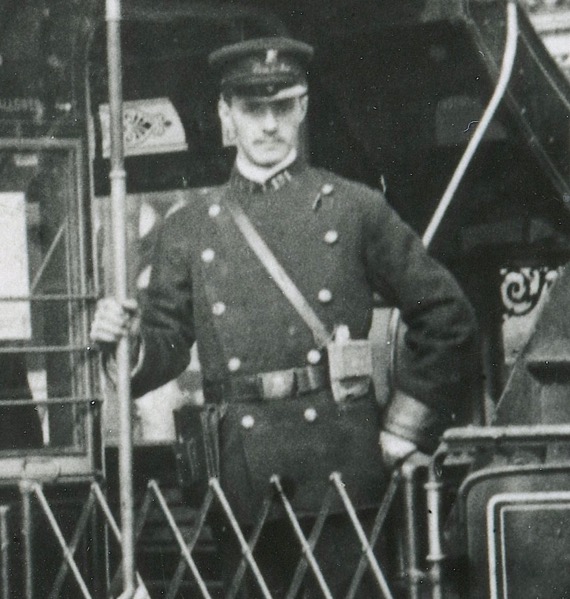
An enlargement of the above photograph showing the conductor (either Employee No 131 or No 151). His left-hand collar bears his employee number, whilst the right collar bears system initials — 'C C T'. His soft-topped cap carries a script-lettering grade badge, mounted below a shield-shaped badge, almost certainly the same municipal device that was used on the early uniform buttons (see link).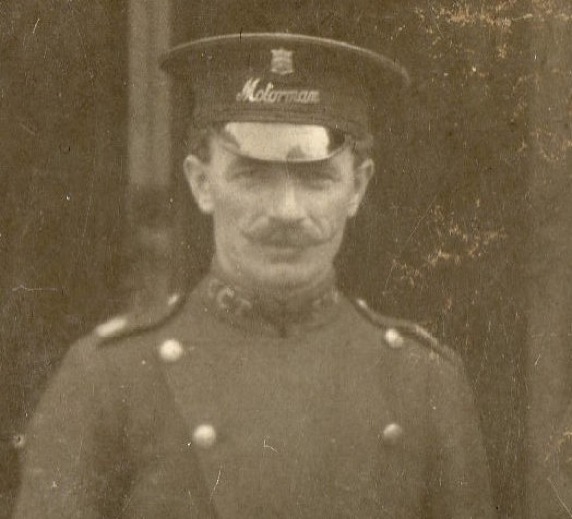
A blow-up of the Wood St staff photo shown below, showing a motorman, who in contrast to all the others depicted, is still wearing the early script-lettering grade badge and municipal-shield badge. This image shows the shield-shaped cap badge reasonably clearly.
Standard ‘off the shelf’ script-lettering grade badges of the type used by Cardiff Corporation Tramways on tramcar crew caps from 1902 to around 1908 — brass. Author's Collection.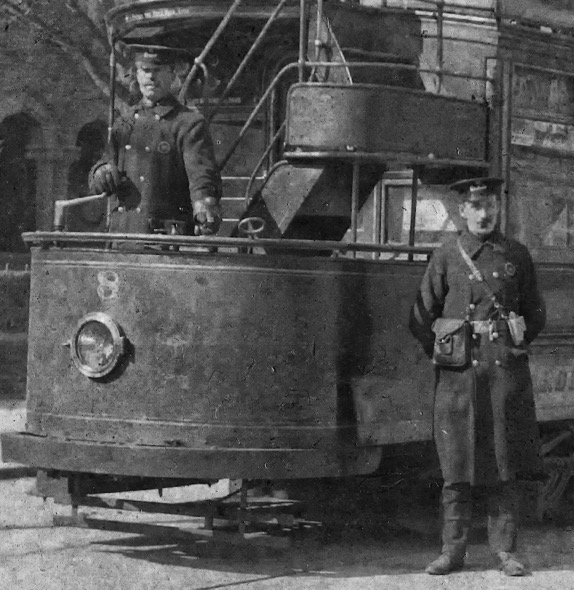
A very badly faded photograph, which had been rescued — to some extent — by modern technology, but one which shows a crew in recently introduced tensioned-crown peaked caps, though still with the early cap badge arrangement — photo undated, but probably mid Edwardian. The tramcar (No 8) is on a Clarence Rd service via St Mary's Rd. Both men are wearing double-breasted greatcoats that are seemingly devoid of insignia, save for a round badge on their left breasts, which may be a municipal licence badge. Richard Rosa Collection.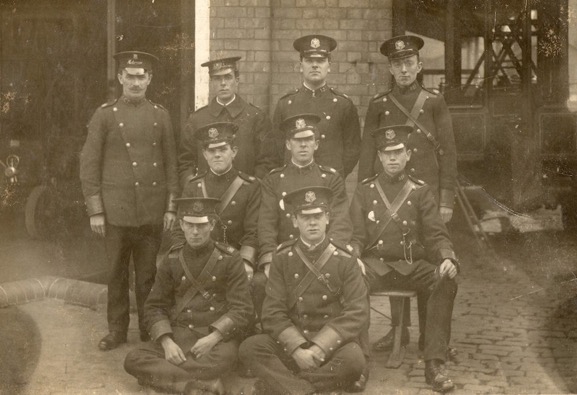
A group of motormen and conductors, captured for posterity, possibly at Wood St depot — photo undated, but probably taken shortly before the Great War. Author's Collection.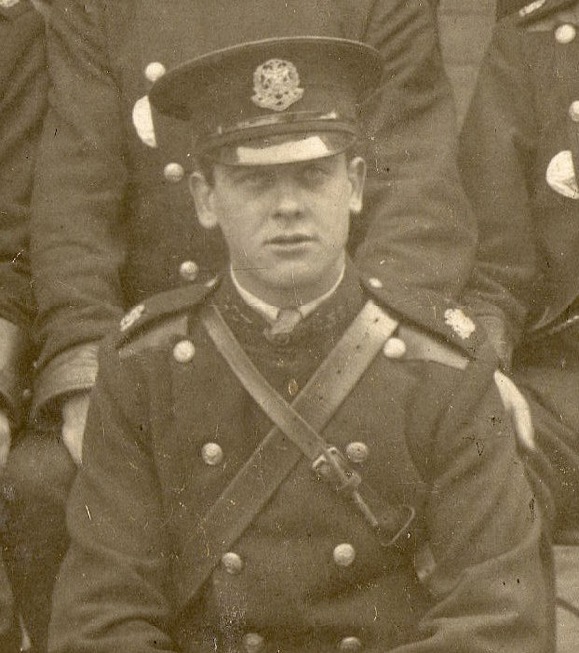
An enlargement of the above photograph showing one of the conductors. The elaborate tramway department cap badge, leather shoulder reinforcements, epaulettes and epaulette badges are easily discerned.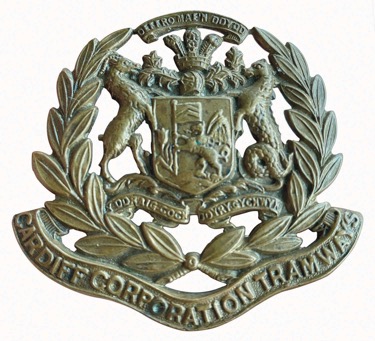
Cardiff Corporation Tramways cap badge — brass — probably introduced in the late-Edwardian era and in use through to the end of the Great War. John Lodge Collection.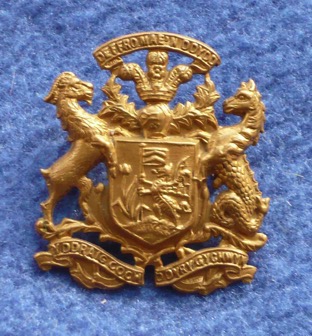
Cardiff Corporation Tramways epaulette badge — brass. This badge was probably introduced within a few years of the grant of the goat and hippocamp supporters to Cardiff in 1907. After the Great War, it also doubled as a cap badge. Author's Collection.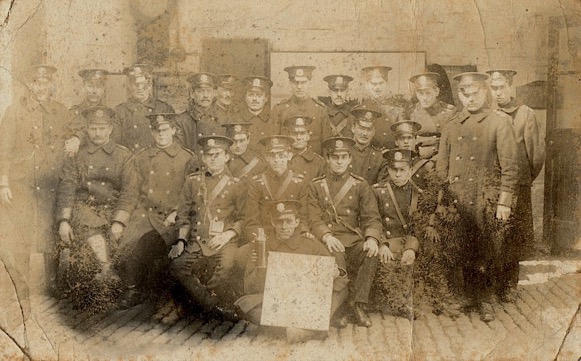
A group of staff pictured at Wood St depot in 1913. Author's Collection.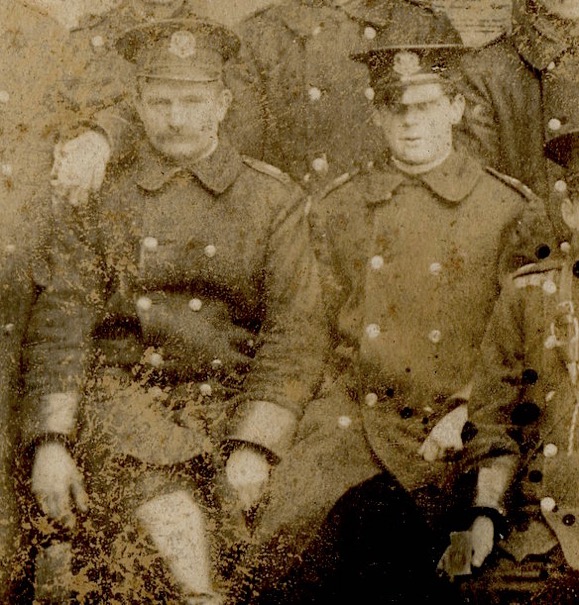
An enlargement of the above photograph showing two of the men wearing greatcoats, the only insignia on the latter being the epaulette badges.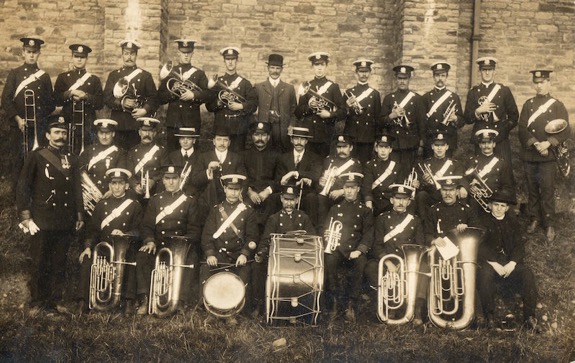
Cardiff Corporation Tramways band — photo undated, but probably taken shortly before the Great War, as only two of the individuals have medals (presumably from the Boer War). Author's Collection.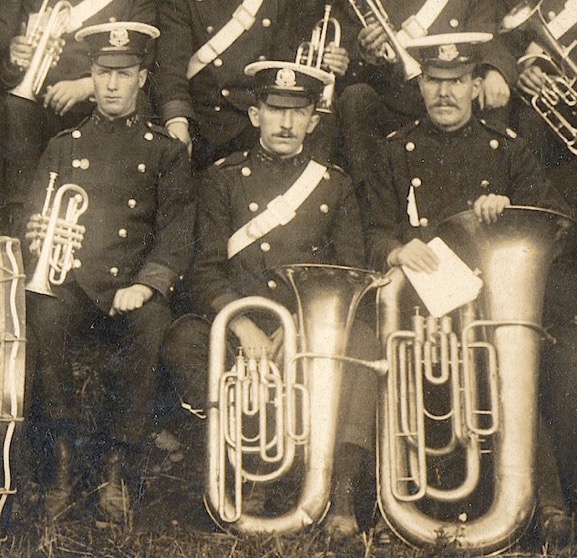
An enlargement of the above photograph showing three of the band members. All are wearing regular tramway uniforms, with tensioned-crown peaked caps bearing the large municipal tramways cap badge.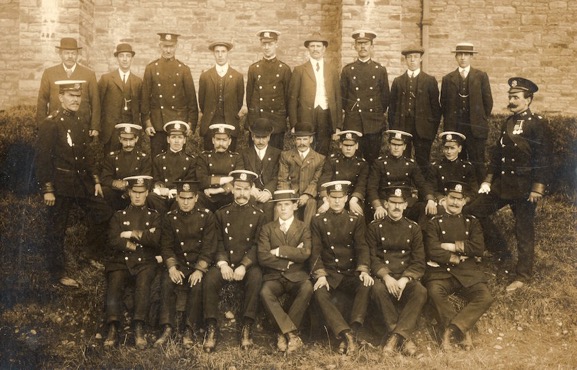
A staff shot that was evidently taken on the same day as the photograph above. Author's Collection.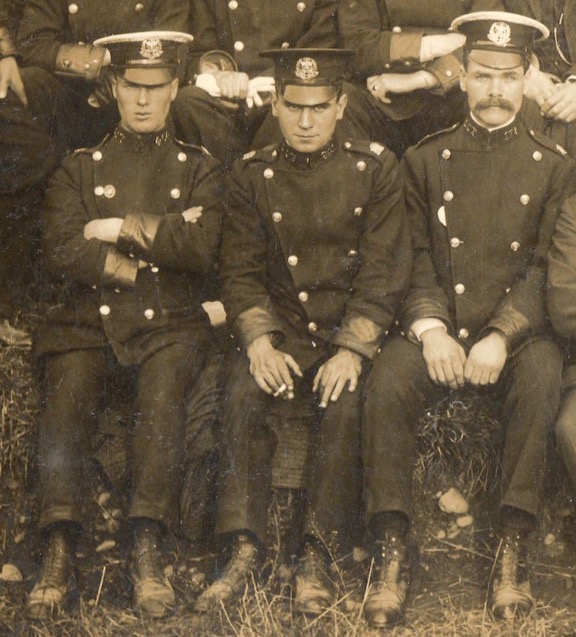
An enlargement of the above photograph showing Employees 464 (or 404), 241 and 178.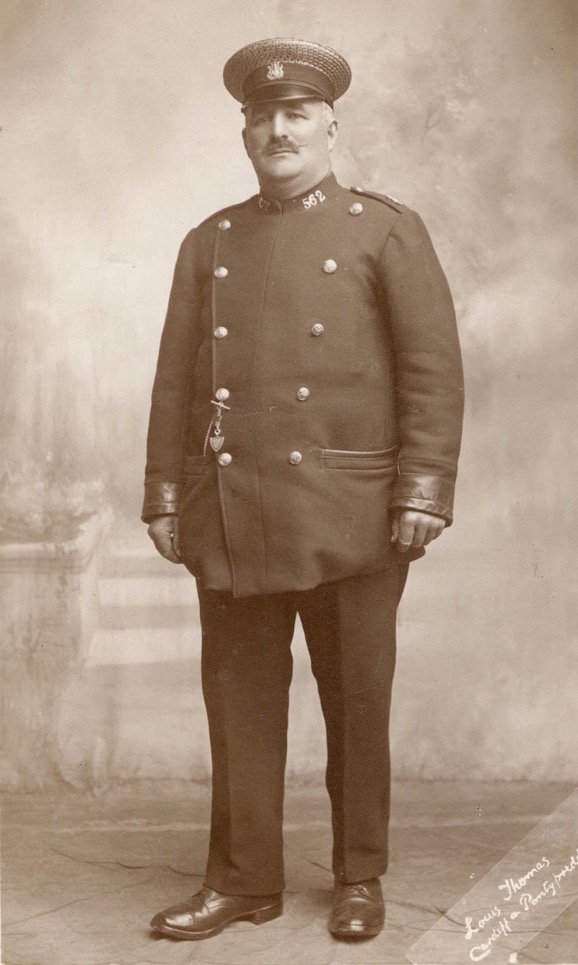
A studio portrait of CCT Employee No 562 — almost certainly a motorman — taken in the studios of Louis Thomas of Cardiff and Pontypridd. The photo is undated, but was probably taken shortly after the Great War. Author's Collection.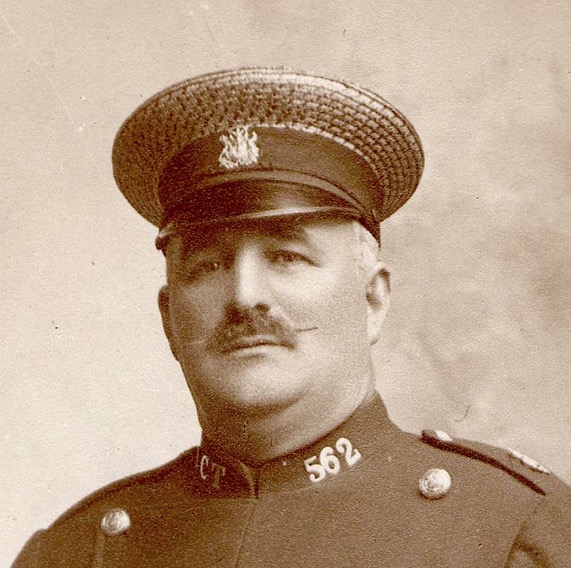
An enlargement of the above photograph showing details of the uniform and cap badge. By this time, the large municipal tramways cap badge had clearly given way to the simpler municipal-device badge that was previously confined to the epaulettes.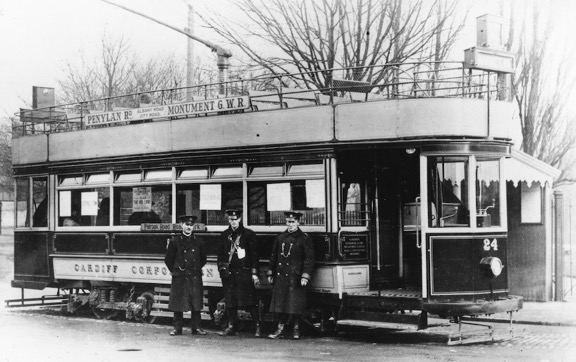
An inspector, a conductor and a motorman with Tramcar No 24 on a Penylan Rd to Market Rd service — photo undated, but probably taken in the 1920s (No 24 was rebuilt into this form in 1921). Author's Collection.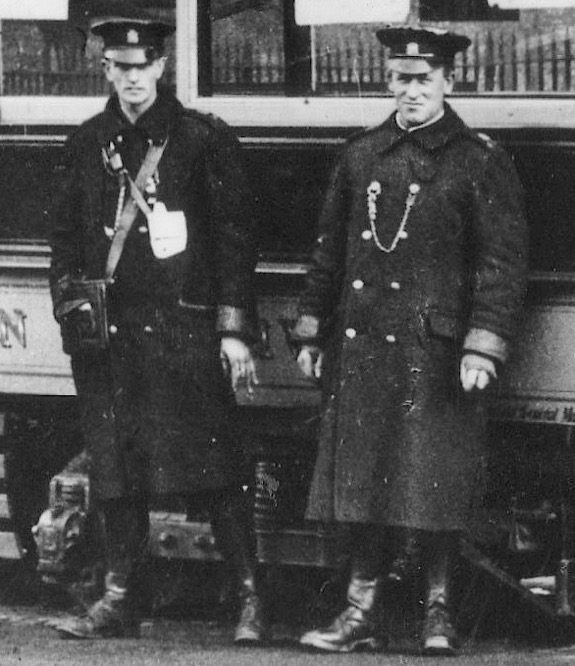
A blow-up of the above photo showing the tramcar crew, both of whom are wearing the small municipal-device badge on their caps.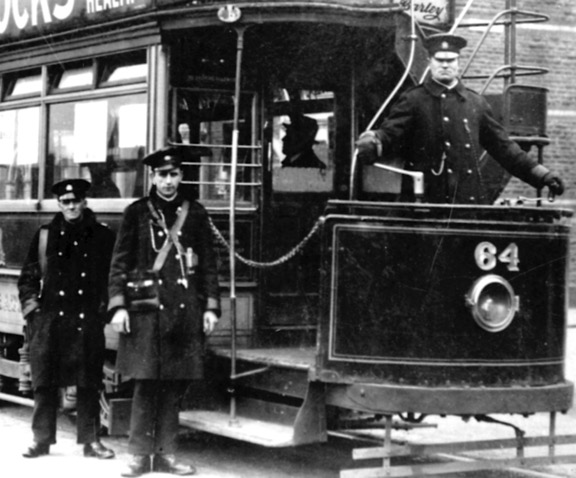
Tramways staff posing with Tramcar No 64 on a service to Cathedral Rd — photo undated, but probably taken in the 1920s. All the individuals in the photo are wearing the smaller cap badge. Photo courtesy of the Tramways and Light Railway Society, with thanks to David Voice.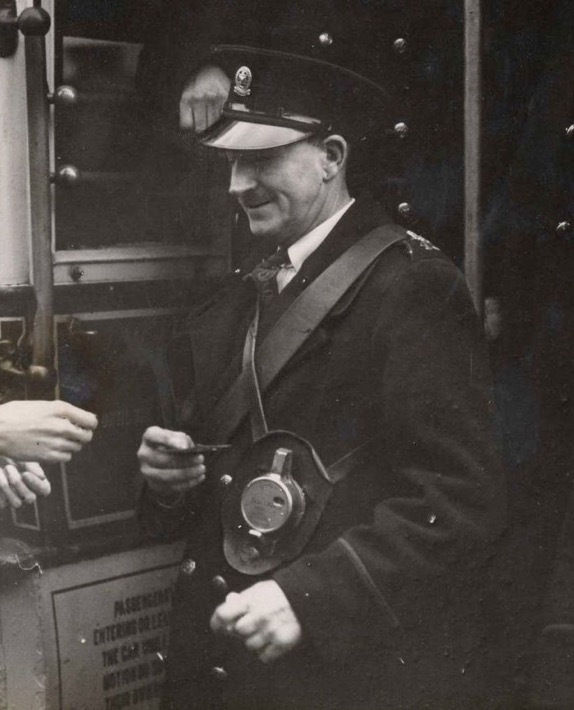
A CCT conductor issues a ticket on a 'Pay as you Enter' tram — photo undated, but probably taken when this particular system was introduced in 1942. He is clearly wearing a standard Cardiff Corporation Transport brass and red enamel cap badge. Source unknown.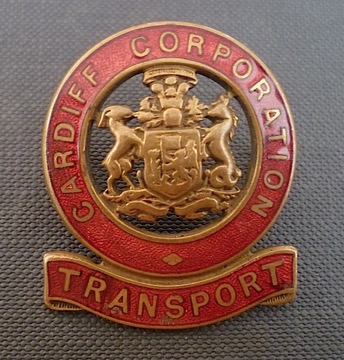
Cardiff Corporation Transport cap badge — brass and red enamel. Probably issued from the mid-to-late 1930s through to the 1950s. Author's Collection.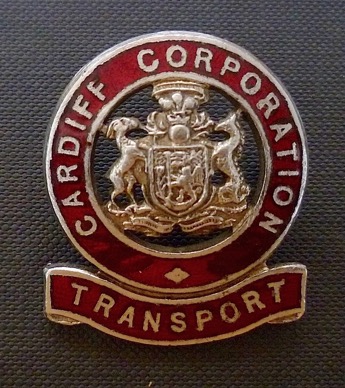
Cardiff Corporation Transport cap badge — chrome and red enamel. A switch was probably made to chrome insignia prior to the demise of the tramway in 1950. Author's Collection.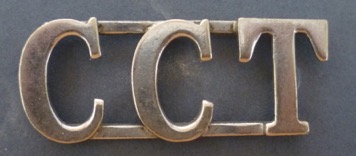
Cardiff Corporation Transport collar initials badge — chrome. Author's Collection.
Senior staff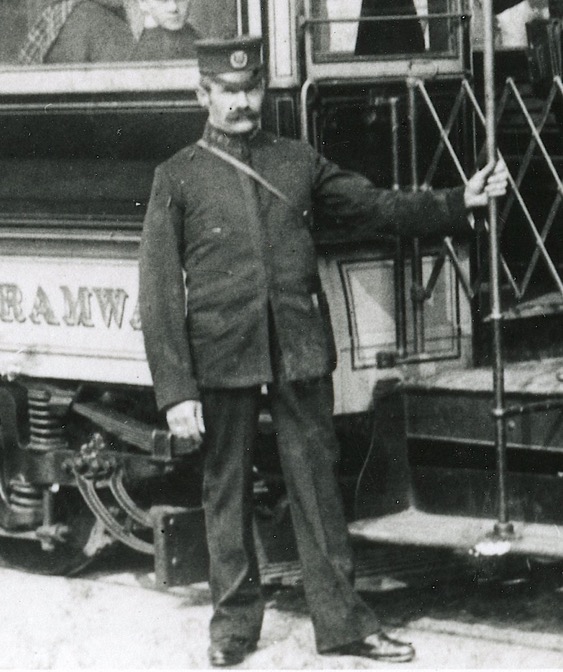
An enlargement of the circa 1904 photograph of Tramcar No 11 shown above, showing the inspector in his drooping-peak cap, which is topped with a pom pom. His left-hand collar bears his grade ('Inspector'), whilst the right bears system initials ('C C T'), all in embroidered lettering. His cap badge is probably embroidered cloth, and more than likely comprised the municipal device within a wreath.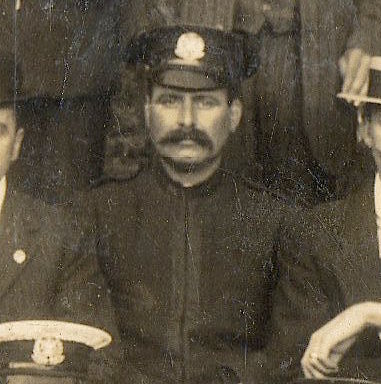
An enlargement of the photograph taken at the same time as the Tramways Band photo above, showing an inspector. His tensioned-crown peaked cap appears to bear the standard, municipal tramways cap badge, though this may well have been deliberately swapped so that he had the same cap badge as the other members of the band (see above).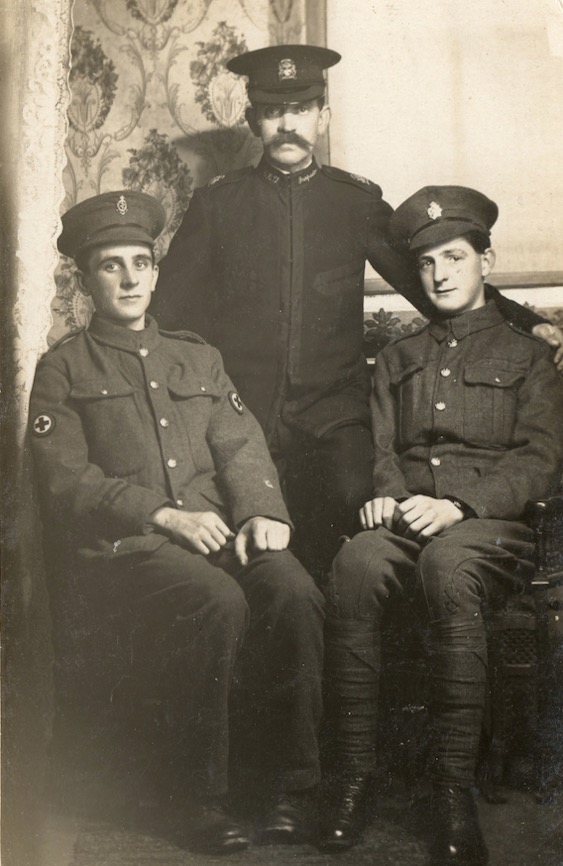
A Cardiff Corporation Tramways inspector and two Great War soldiers, more than likely his sons. The man on the left is a member of the Royal Army Medical Corps, and the one on the right, possibly the Devonshire Regiment. Author's Collection.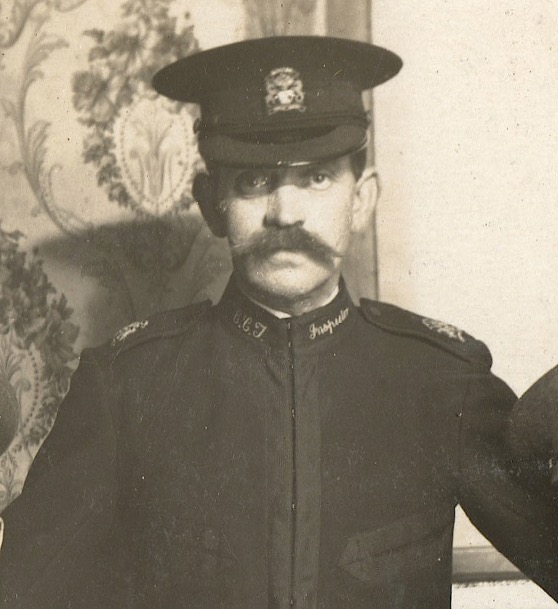
An enlargement of the above photograph showing details of the inspector's uniform and cap badge. The cap and epaulette badges are similar to, though noticeably more elaborate than the brass municipal-device badge that was worn on the epaulettes of tramcar crews.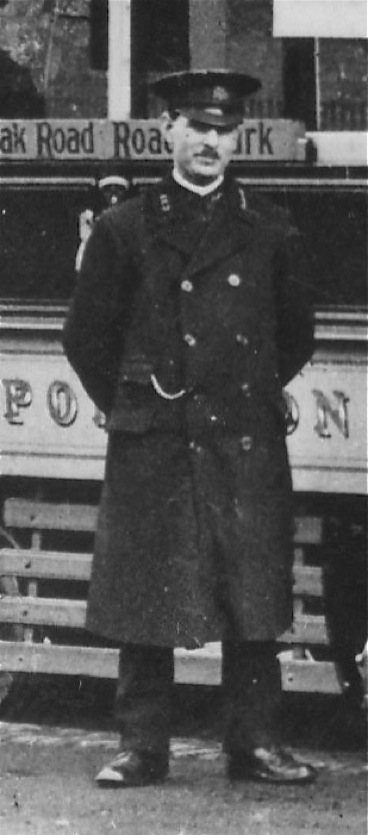
An enlargement of the photograph of Tramcar No 24 above, taken in the 1920s, showing the inspector. His overcoat bears system initials on one collar and his grade on the other.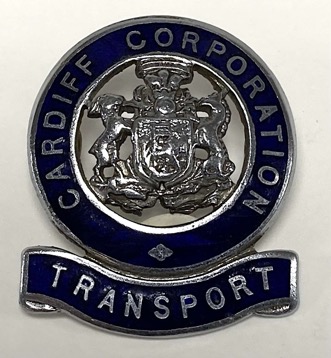
Cardiff Corporation Transport cap badge — chrome and blue enamel. This pattern of cap badge was probably issued from the mid-to-late 1930s through to the 1950s, initially in brass but later in chrome. With thanks to the National Tramway Museum.
Female staff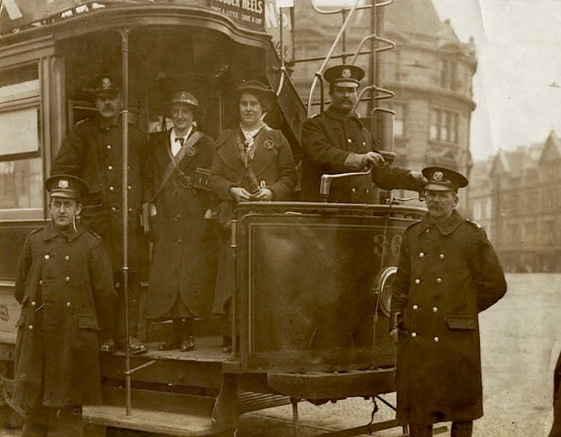
Two CCT Great War conductresses and four other tramcar crewmen posing for what looks to be a semi-official shot (perhaps a newspaper?) on the platform of Tramcar 36 — photo undated, though it seems a reasonable possibility that it was taken to commemorate the first service worked by conductresses (probably in 1917). The conductor standing at street level on the left is Archibald Walter Bromley, who died in October 1924 from septicaemia following a blow on the head when turning a trolley pole, probably from a detached trolley head — I am indebted to Christopher Jones for this information, Conductor Bromley's great grandson. Photo courtesy of the Tramways and Light Railway Society, with thanks to David Voice.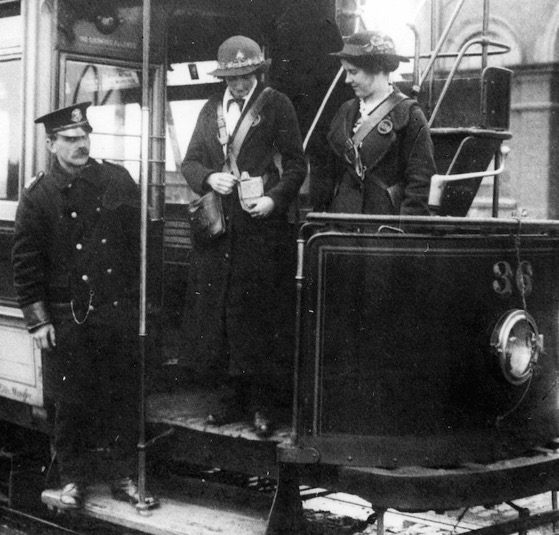
Another shot of Tramcar No 36 and what would appear to be the same two ladies, so presumably taken on the same day as the photograph above. Both are wearing completely informal attire, the only indicator of their official capacity being the round licence badges on their coat lapels, which appear to be the same as those used in the mid-Edwardian era. Photo courtesy of the Tramways and Light Railway Society, with thanks to David Voice.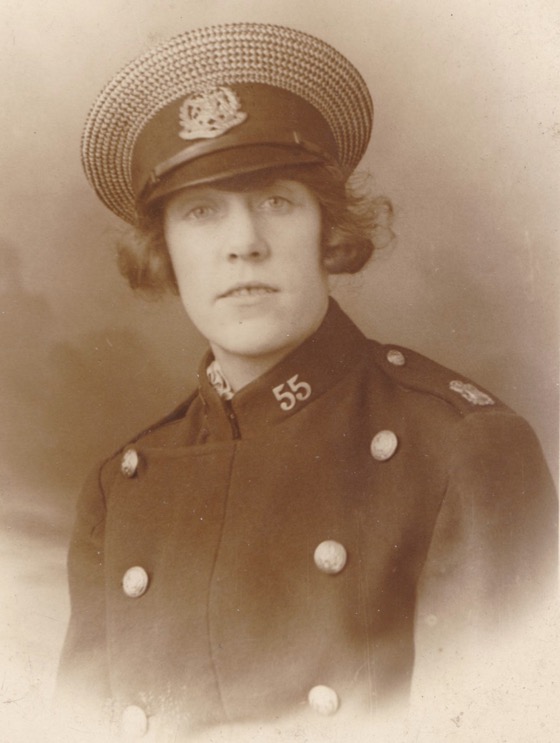
A CCT Great War female employee (No 55). The subject is wearing a lancer-style tunic similar to those worn by her male colleagues, though in all probability it would have been tailored specifically for female staff. With thanks to the Geoff Caulton Collection.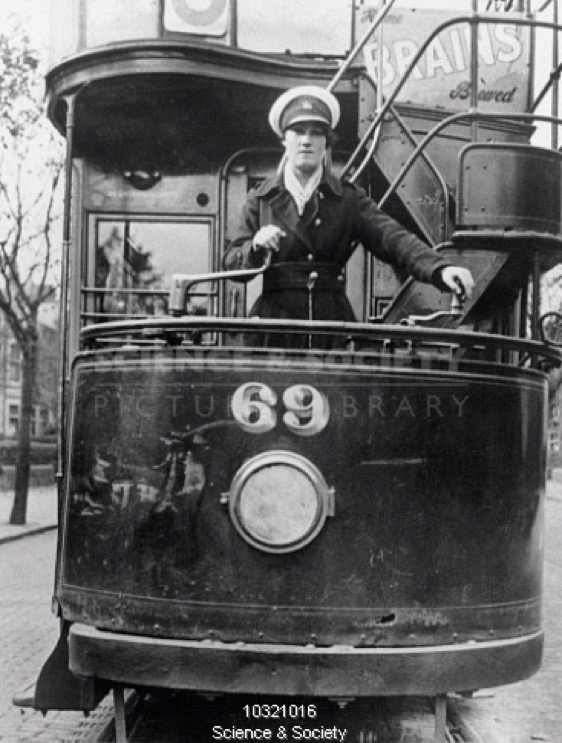
One of Cardiff's two Great War motorwomen at the controls of a somewhat lop-sided and rather battered Tramcar No 69. She is wearing a small cap badge, which is more than likely a regimental sweetheart badge (possibly a 16th 'City of Cardiff' Battalion badge — see below). With grateful thanks to the Science and Society Picture Library (see link).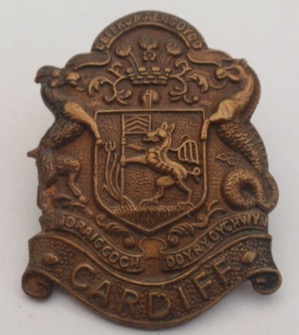
16th City of Cardiff Battalion badge. During the Great War, the wearing of regimental cap badges was common practice amongst tramway staff the length and breadth of the UK, to show support loved ones serving in the armed forces. With thanks to Stephen Howarth.